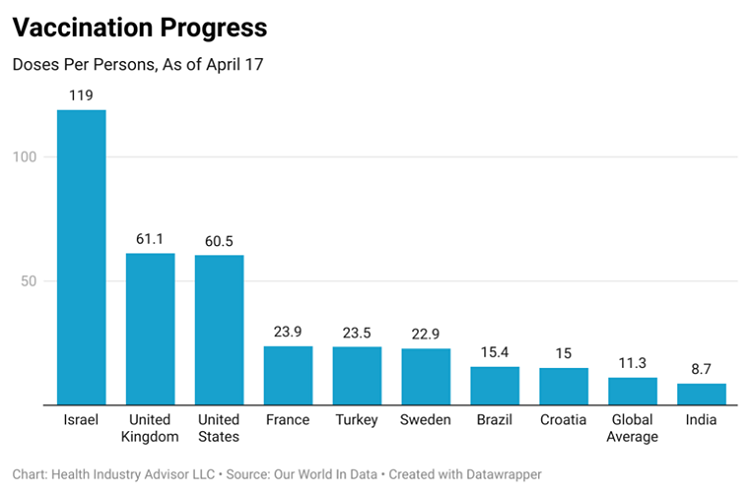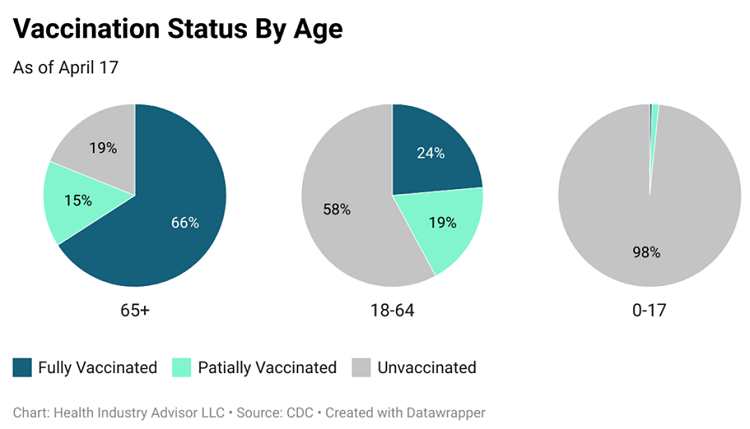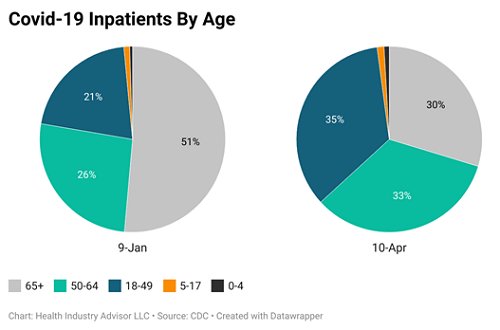April 19, 2021 – The path to normalcy came into focus this week. Will we have the resolve and the leadership to navigate this path?
Two reports this week delivered resounding evidence that vaccines provide robust virus protection. This protection extends to the currently circulating variants.
First, the CDC reported on a study of 66 million people who had completed the vaccination protocol. COVID infected only 5,800, and most cases were mild.
Then, Yair Lewis, MD, shared his analysis of 460,000 COVID infections in Israel. He found that 85% of the infections occurred in unvaccinated persons. Only 14% occurred in those partially vaccinated. Most infections occurred within one to two weeks of receiving the first dose. The infection rate for fully vaccinated persons was under 1%.
The conclusion: Vaccines Work.
In the presence of highly transmissible variants, the pace of a country’s vaccination effort is critical. Israel flew from the starting gate fastest among all large countries. Fortunate that it did, as the B117 variant hit Israel hard. In January, Israel suffered the highest infection rate per capita in the world. Moving quickly, it vaccinated half its residents by March 16. The payoff: infection rates have plummeted 98% since peaking in January. Israel now enjoys one of the lowest infection rates in the world.
The United Kingdom followed a similar pattern. In early January, the U.K.’s infection rate exceeded most countries, including Israel. Since that time, this rate has plunged 96%. The U.K.’s vaccination effort, one of the most aggressive globally, has played a vital role. How aggressive is the U.K.’s vaccination effort? The country has administered five times as many doses per person as the worldwide average. Its rate is two-and-one-half times that of the European Union.
COVID infections started spiking outside the U.S. on February 19, more than doubling (2.4x) since that day. The variants have hit India hardest recently – new daily cases have doubled in the past nine days and have quadrupled in the last three weeks. Brazil, with two-thirds the population, is seeing as many new cases each day as the U.S. and one-quarter of all recent COVID deaths globally.
Croatia, France, Sweden, and Turkey report the highest per capita new case rates of large countries.
What do these countries share in common? Low vaccination uptake. France leads this group but has administered only 24 doses per 100 people. India trails far behind, at nine doses per 100.

The United States is in the midst of its fourth wave of infections. This wave would likely be substantially worse if not for a robust vaccination effort.
The initial three waves commenced in March, June, and October 2020. Within a month, cases exploded 200 to 300% each time.
In the first month of this fourth wave, the highly transmissible B117 variant fueled new infections. Still, new cases grew only 30% – six to ten times slower than during earlier waves.
Vaccines are sparing the United States from the explosion in infection rates seen during these earlier waves.
How robust is the U.S. vaccination effort? In less than four months, one-fourth of the entire population has already completed the vaccination protocol. Among senior citizens, two-thirds have done so.

Participation levels to date have been impressive. But we will soon see the scope of vaccination hesitancy, particularly among younger adults.
Four in five senior citizens have participated thus far in the vaccination effort. COVID poses more significant risks to older people so, this participation rate is understandable.
A robust vaccination program lowers the risk of COVID-19 deaths. Deaths reported with COVID-19 in the U.S. fell last week for the eleventh straight week. These were the fewest deaths during any week in nine months.
Another benefit of high vaccination rates should be fewer COVID-19 inpatients. Indeed, the average daily census of COVID-19 patients declined 72% from January 6 through March 16. But patient days increased 18% since. The inpatient population has shifted younger too. In early January, there were as many senior citizens as younger adults hospitalized with COVID-19. More recently, younger adult patients outnumbered senior citizens more than two-to-one. So, vaccinating senior citizens worked. But unvaccinated younger adults fill our nation’s inpatient beds.

Now comes the test. Will younger adults take part in vaccinations at a high level? The early returns are good, but we are approaching the point where resistance will be evident. As of today, everyone 16 years and older is eligible. Four in ten persons 18 to 64 years old have already started the effort. Half have completed it.
Public health officials will play a vital role in influencing the public. Are the vaccines as safe and effective as the evidence indicates? If so, public officials must inspire vaccine adoption. Equivocation about what vaccinated persons can and cannot do only promotes hesitancy. Failure to set clear guidelines for the safe use of the Janssen vaccine means fewer people have vaccine access.
Will participation continue to grow? Or will the U.S. soon find its point of resistance among young adults? Answers to these questions will determine if and when we return to normal.
Contributing writer:
Mark A. Van Sumeren, strategic advisor, Medical Devices & Integrated Delivery Networks
Health Industry Advisor LLC, provides a regular report on COVID-19 numbers for the health care industry.
For more information, or to sign up for the report, contact Mark at Mark.VanSumeren@HealthIndustryAdvisor.com; or visit www.HealthIndustryAdvisor.com.
